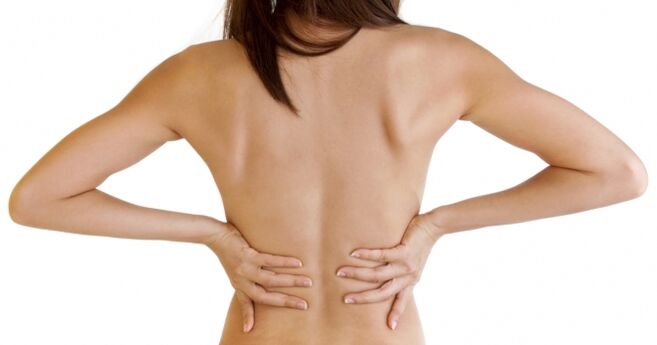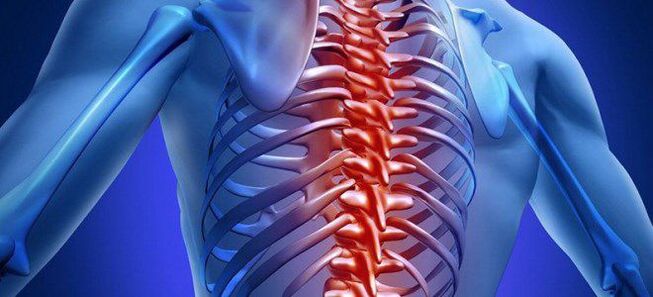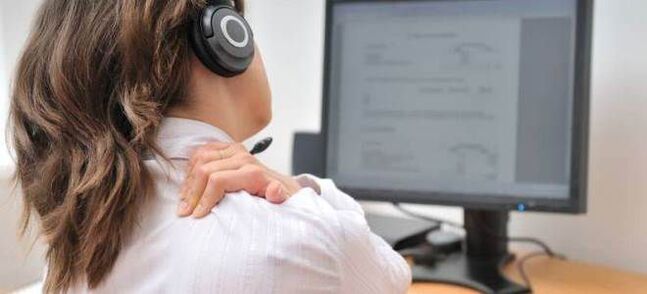
Recently, doctors have received more and more complaints about back pain, and young women often suffer from it. If the discomfort is localized in the thoracic spine, then it may be caused by a disease such as thoracic osteochondrosis, the symptoms of which are described in detail below.
Thoracic osteochondrosis - causes
Vertebral osteochondrosis is a pathology in which negative changes occur in the tissues of the intervertebral discs - elements of the spine located between the two vertebral bodies. The intervertebral disc is a kind of round, flat pad consisting of a gel-like collagen core, fibrous cartilaginous tissue and vitreous connective tissue. The main functions performed by these structures are:
- connection and retention of adjacent vertebral bony bodies;
- shock-absorbing protection of the spine, protecting against injuries due to gravity and body loads;
- ensure mobility of adjacent vertebrae in relation to each other.
If the intervertebral discs are in a satisfactory functional state, the spine is endowed with elasticity, mobility and the ability to withstand various mechanical loads. When the cartilage structure changes its shape, texture, loses its strength and elasticity, these functions cannot be fully performed. Basically, this occurs against the background of metabolic disorders.

In part, the pathological changes in the intervertebral discs that cause thoracic osteochondrosis are explained by the fact that with age, their nutrition through their own blood vessels stops and the supply of nutrients becomes possible only thanks to theneighboring structures (ligaments, vertebral bodies). The exact causes of poor nutrition of intervertebral structures and the mechanism of their destruction are unknown, but doctors identify a number of predisposing factors:
- systemic metabolic disorders in the body;
- excessive body weight;
- poor diet, drinking regime;
- inactivity;
- sedentary work;
- bad position;
- flat foot;
- injury to the back, spine;
- intense physical work or sports training;
- pregnancy;
- wear uncomfortable shoes, high heels.
Degrees of thoracic osteochondrosis
A disease such as thoracic osteochondrosis does not show symptoms immediately, as it develops gradually and over a long period of time. In addition, due to the low mobility of the spine in this area, osteochondrosis of the thoracic region manifests itself in later stages, in the presence of significant pathological changes. In total, four degrees of pathology are distinguished, depending on the deviations developed.
Thoracic osteochondrosis 1st degree
The preclinical stage is grade 1 osteochondrosis of the thoracic spine. At this stage, partial dehydration and compaction of the central part of the intervertebral discs occurs, their height decreases, which leads to a decrease in their elasticity and firmness. The ability of the spine to withstand usual loads is always preserved. Disc protrusions begin to form.
Thoracic osteochondrosis 2nd degree
When thoracic osteochondrosis grade 2 develops, the disease is characterized by the appearance of cracks in the annulus fibrosus. Sagging (thinning) of the discs continues, the amount of intervertebral fluid decreases significantly, and the vertebrae begin to rub against each other as the load on the back increases. This stage is sometimes called discogenic radiculitis.

Thoracic osteochondrosis 3rd degree
Osteochondrosis of the thoracic spine of the 3rd degree is accompanied by destruction and rupture of the fibrous tissues of the disc, release of the central part, i. e. the formation of a hernial protrusion of theintervertebral disc occurs. As a result, nerve roots begin to be pinched, neighboring vessels are compressed, and veins and arteries are pinched.
Thoracic osteochondrosis 4 degrees
The last, most serious stage of the disease is characterized by displacement, twisting, deformation of the vertebral bodies, a further increase in their surface area and proliferation. The affected fibrous disc tissue begins to be replaced by bone tissue in the form of specific growths - osteophytes, compressing the spinal cord. As a result, spinal mobility is significantly reduced.
Osteochondrosis of the thoracic spine - symptoms
Due to the peculiarities of the localization of pathological processes, osteochondrosis of the thoracic region has both typical and atypical symptoms, repeating the manifestations of other diseases. This is due to the fact that due to compression of blood vessels and nerve fibers, structural changes in the spine, the functions of neighboring internal organs are disrupted.
Let's list which symptoms of thoracic osteochondrosis are characteristic and most common:
- pain in the back and chest;
- feeling of compression in the chest;
- tingling sensations in the limbs;
- numbness of arms, legs, neck, and shoulders;
- stiffness, pain in the back and limbs;
- muscle spasms in the upper and middle back;
- limited mobility of the spine in this area (difficulty bending the body).
Pain due to osteochondrosis of the thoracic spine
When "thoracic osteochondrosis" is diagnosed, symptoms associated with pain appear among other complaints. Their intensity and duration depend on the stage of the pathological process. The location of the pain can change periodically and quickly, for example, moving from one area of the chest to another, covering the entire chest. The pain is often felt in the area between the shoulder blades. The nature of pain in thoracic osteochondrosis is dull, compressive and sharp. Increased pain is observed at night and with:
- To raise hands;
- the neck turns;
- carry heavy objects;
- sudden movements;
- increased physical activity;
- heavy breathing, coughing, sneezing;
- hypothermia.
Can there be shortness of breath with thoracic osteochondrosis?
Due to the displacement of vertebral bodies, pathological changes in the structure of the chest, pinching of nerve fibers and blood vessels associated with the lungs, shortness of breath often occurs with thoracic osteochondrosis. Additionally, becausein the thoracic region there are structures responsible for the innervation of the heart, intestines, liver, kidneys and some other organs; the disease in many cases is accompanied by the following symptoms:
- headache, dizziness;
- pain in the heart region;
- pain in the mammary glands;
- pain in the hypochondrium (similar to the appearance of pancreatitis, cholecystitis);
- epigastric pain not associated with food;
- discomfort in the pharynx, esophagus, foreign body sensation;
- sexual dysfunctions.
Pain in the heart with thoracic osteochondrosis, often pressing, squeezing, can be misleading during diagnosis, because it is similar to the manifestations of angina, myocardial infarction. A feature of these sensations is their long duration and lack of effect when taking medications to dilate the vessels of the heart. There is no change in the cardiogram.

Syndromes with thoracic osteochondrosis
Symptoms of thoracic osteochondrosis in women, associated with a single mechanism of occurrence, in many cases present themselves in a complex manner. There are two syndromes with a set of specific pathologies caused by thoracic osteochondrosis:
- back pain;
- dorsal.
Thoracic spine back pain
Prolonged, mild pain associated with thoracic osteochondrosis in women, often characterized by aching and tightness, is inherent in back pain. Complaints may persist for 2 to 3 weeks, with discomfort easing slightly (especially when walking) or intensifying (often at night, when bending over or breathing deeply). In the presence of this syndrome, thoracic osteochondrosis may also present with symptoms associated with difficulty breathing and muscle stiffness.
Dorsago of the thoracic spine
Paroxysmal manifestations of the disease are called "dorsago" or "thoracic lumbago". In this case, the pain appears suddenly, sharply, often resembling the signs of a heart attack. An attack of thoracic osteochondrosis has the following symptoms:
- sharp, dagger-like pain;
- pain is felt in the area between the ribs, the interscapular area;
- often an attack appears after a long stay in one position;
- the pain intensifies when rotating the torso;
- there are breathing difficulties, severe muscle tension.
Osteochondrosis of the thoracic spine - consequences
If treatment of the pathology is not started on time, osteochondrosis of the thoracic region can lead to the following consequences:
- vegetative-vascular dystonia;
- migraine;
- disruption of the functioning of internal organs (liver, kidneys, etc. );
- decrease in hearing, vision;
- epicondylitis of the elbow joint;
- paresis and paralysis of the arms;
- rachiocampsis;
- loss of sensitivity of skin tissues;
- disability, etc.

How to treat thoracic osteochondrosis?
If symptoms of thoracic osteochondrosis appear, it is recommended to consult a neurologist who, after examining the back and examining the spine in several positions of the patient, will be able to make a primary diagnosis. To determine the extent of damage, x-rays, magnetic resonance imaging or computed tomography are prescribed. Treatment tactics depend on the results obtained.
Often, painful symptoms of thoracic osteochondrosis of the spine are eliminated by taking nonsteroidal anti-inflammatory drugs. In case of exacerbation accompanied by severe pain, paravertebral blocks with an anesthetic solution can be performed. Additionally, the following drugs can be prescribed as part of conservative treatment:
- muscle relaxers;
- chondroprotectors;
- corticosteroids, etc.
To improve metabolic processes, eliminate muscle hypertonicity and prevent various complications, the following treatment methods are used:
- physiotherapy;
- massage;
- manual therapy;
- spinal traction;
- physiotherapeutic procedures (laser, ultrasound, etc. ).
Surgical treatment is necessary in the event of compression of the spinal cord by a fragment of the intervertebral disc. In this case, we can carry out either a laminotomy - excision of the vertebral arches, or a discectomy - removal of part of the intervertebral disc or its complete removal with placement of a graft. In clinics with modern equipment, surgical interventions are carried out using low-traumatic methods through small incisions.

























